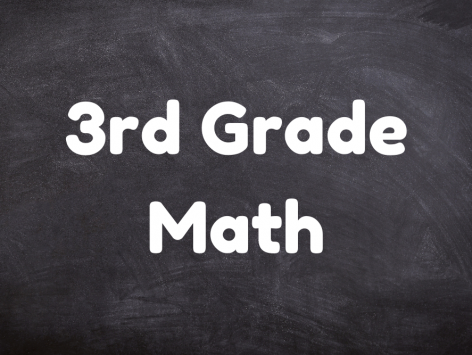This is where you will find all of resources for our 3rd Grade Math Curriculum.
You must be logged in or Join the Math Teacher Community to Access this Content.
Course Materials
Units
Unit 1 – Properties of Multiplication and Division
- 1-1 Multiplication as “Equal Groups of”
- 1-2 Array Model
- 1-3 The Meaning of Factors
- 1-4 Division as an Unknown Factor: The Size of the Group
- 1-5 Division as an Unknown Factor: The Number of Groups
- 1-6a The Commutativity of Multiplication
- 1-6b Adding and Subtracting Equal Groups in Array Models
- 1-6c Model the Distributive Property with Arrays
- 1-7a Model Division as an Unknown Factor
- 1-7b Quotient as the Number of Groups or the Number of Objects in Each Group Using Units of 2
- 1-7b Quotient as the Number of Groups or the Number of Objects in Each Group Using Units of 3
- 1-8a Skip Counting to Multiply Units of 4
- 1-8b Model Commutative Property of Multiplication with Arrays and Tape Diagrams
- 1-8c The Relationship Between Multiplication and Division
- 1-9 Decomposing Units Using the Distributive Property
- 1-10 Problem Solving Using Units of 2-5, and 10
- Unit 1 - Properties of Multiplication and Division - Review Guide & Test
- Unit 1 Projects
Unit 2 – Place Value, Measures of Time, Weight and Liquid Volume
- 2-1 Skip Counting By Five to Tell Time
- 2-2 Tell Time to the Nearest Minute On the Clock
- 2-3 Solve Problems Involving Time Intervals By Counting Backward and Forward
- 2-4 Solve Problems Involving Time intervals By Adding and Subtracting on a Number Line
- 2-5 Measuring Weight in Metric Units
- 2-6 Measuring Liquid Volume in Metric Units
- 2-7 Solve Problems Involving Weight, and Liquid Volume in Metric Units
- 2-8 Round Two- and Three-Digit Numbers to the Nearest Ten
- 2-9 Round Numbers to the Nearest Hundred
- 2-10a Add Measurements to Compose Larger Units Once
- 2-10b Add Measurements to Compose Larger Units Twice
- 2-10c Estimating Sums by Rounding
- 2-11a Decompose Once to Subtract Measurements
- 2-11b Decompose Twice to Subtract Measurements
- 2-11c Estimating Differences by Rounding
- Unit 2 – Place Value, Measures of Time, Weight and Liquid Volume - Review Guide & Test
- Unit 2 - Project: Grocery Receipt Place Value
Unit 3 – Multiplication and Division of with Units 0, 1, 6-9, and Multiples of 10
- 3-1 Find Known Facts of 6, 7, 8, and 9 by Commutativity
- 3-2 Relating Multiplication Facts Using Commutative and Distributive
- 3-3 Multiply and Divide Using a Letter to Represent the Unknown
- 3-4a Multiply by Counting Units of 6 and Divide Using Number Bonds
- 3-4b Multiply by Counting Units of 7 and Divide Using Number Bonds
- 3-4c Multiply and Divide Units of 6 and 7 Using the Distributive
- 3-4d Solve Problems Using Units of 6 and 7
- 3-5a Role of Parentheses
- 3-5b Multiply Using the Associative Property
- 3-5c Multiply and Divide Using the Distributive Property
- 3-5d Solve Problems Using Units Up to 8
- 3-6a Multiply Using Arithmetic Patterns
- 3-6b Solve Problems Using Units of 9
- 3-7 The Arithmetic Patterns in Multiplication and Division
- 3-8 The Multiplication Table
- 3-9 Solve Two-Step Word Problems Involving the Four Operations
- 3-10 Multiply by Multiples of 10
- 3-11 Solve Two-Step Word Problems in Multiplying Single-Digit Numbers by Multiples of 10
- Unit 3 – Multiplication and Division of with Units 0, 1, 6-9, and Multiples of 10 - Review Guide & Test
- Unit 3 - Project: Multiplication Table Grid Drawing
Unit 4 – Multiplication and Area
- 4-1 Decomposing and Recomposing Shapes
- 4-2 Measure Area by Tiling with Unit Squares
- 4-3 The Relationship of Side Lengths with the Number of Tiles on a Side
- 4-4 Tiling with Unit Squares to Form a Rectangle
- 4-5 The Area of a Rectangle Given an Incomplete Array
- 4-6 Finding the Area of a Rectangle Using Multiplication
- 4-7 Finding the Total Area of a Larger Rectangle
- 4-8 Finding the Possible Whole Number Side Lengths of a Rectangle
- 4-9 Finding Areas by Decomposing or Completing Composite Figures
- 4-10 Solve Problems Involving Area
- Unit 4 - Multiplication and Area Review Guide and Test
- Unit 4 Project: My Dream Garden Multiplication & Area
Unit 5 – Unit Fractions and One Whole
- 5-1 Naming and Counting Unit Fractions Using Concrete Models
- 5-2 Naming and Counting Unit Fractions Using Area Models
- 5-3 Identify Fractional Parts of a Whole
- 5-4 Identify Unit Fractions Numerically
- 5-5 Non-Unit Fractions Less than One Whole
- 5-6 Shaded and Non-Shaded Parts of One Whole as Fractions
- 5-7 Fractions Greater than One Whole
- 5-8 Comparing Unit Fractions
- 5-9 Place Fractions on a Number Line
- 5-10 Compare Fractions and Whole Numbers on a Number Line
- 5-11 Equivalent Fractions
- 5-12 Comparing Fractions with the Same Numerator Visually
- 5-13 Comparing Fractions with the Same Numerator Using <, >, and =
- Unit 5 – Unit Fractions and One Whole Review Guide and Test
- Unit 5 Project: Fraction Detective in Everyday Life
Unit 6 – Categorical and Measurement Data
- 6-1 Creating and Organizing Categorical Data
- 6-2 Draw Tape Diagrams to Represent Data
- 6-3 Creating Bar Graphs
- 6-4 Solve Problems Involving Graphs
- 6-5 Creating a Ruler with 1 Inch, 1/2 Inch and 1/4 Inch Intervals
- 6-6 Represent Measurement Data Using Line Plots
- 6-7 Data Analysis to Solve Problems
- Unit 6 – Categorical and Measurement Data Review Guide and Test
- Unit 6 Project: Measuring Seedling Growth
Unit 7 – Two-Dimensional Figures, Perimeter, and Area
- 7-1 Classify and Compare Quadrilaterals
- 7-2 Classify and Compare Polygons
- 7-3 Understand Perimeter by Decomposing Quadrilaterals
- 7-4 Measure Side Lengths to Determine the Perimeter of Polygons
- 7-5 Determine the Perimeter of Regular Polygons and Rectangles
- 7-6 Find the Perimeter of Rectangles Given the Number of Unit Squares
- 7-7 Find the Area of Rectangles Given the Perimeter
- 7-8 Solve Word Problems Involving Perimeter and Area
- Unit 7: Review Guide and Test
- Unit 7 Project: Two-Dimensional Designers


